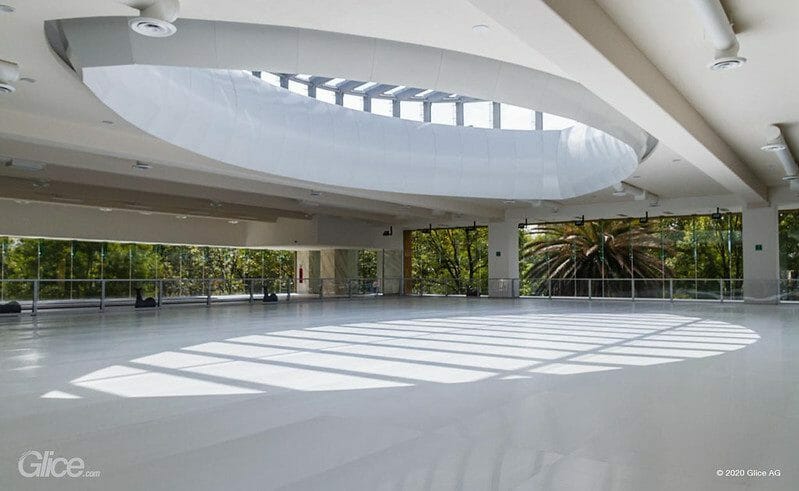For figure skaters, ice hockey players, or any venue looking for a unique attraction, having access to an all-year-round ice rink can be a game changer. There are two main types of skating rinks: refrigerated ice and synthetic ice made of engineered plastic panels. While electricity-powered ice has been around for decades, artificial or synthetic ice has rapidly grown in popularity for the past 10 years. In this article, we’ll go over the main differences between the two types of skating rinks and cover everything required to understand ice rink maintenance. Forget about ice resurfacers and say hello to effortless ice skating fun.
Refrigerated ice vs. synthetic ice
Before we dig into all the details of synthetic ice maintenance, let’s provide you with some helpful information about some major differences between Glice synthetic ice and refrigerated ice rinks. Because not only is maintenance much easier with Glice, but there are many other benefits to choosing Eco Ice:
- Low operating costs: Operating a Glice synthetic ice rink is 49% more economical than operating traditional ice rinks. Why? Synthetic ice does not require water, coolants, condensers, or the like, which usually causes high additional costs.
- No water consumption: Installing Eco Ice instead of refrigerated ice can save you 12,000 to 15,000 gallons (45.000 bis 60.000 liters) of water.
- Lower starting costs: The starting costs of a Glice Eco Ice rink can be from 20% to 50% lower than those of energy-powered ice rinks, which can easily cost $1.5 million or more.
- Low maintenance: Refrigerated ice requires a lot of maintenance by plumbers and other specialized technicians. Artificial ice, on the other hand, keeps maintenance to a minimum. This also results in much lower spending.
- No Zambonis: Our rinks do not need an ice resurfacer. That way, skaters can spend more time on the ice. Below, you will find out how to maintain a smooth surface on Glice.
- More fun: Generators cause a lot of noise that makes traditional ice rinks uninviting, while synthetic ice is quiet and, therefore, much more enjoyable. Additionally, artificial ice panels can be installed in a warm place or anywhere else instead of a freezing ice arena.
Many more reasons will convince you of the benefits of Glice. Find them all here!
Why is synthetic ice the best option?
The panels are made for any weather condition and can be used all year round, as opposed to refrigerated ice. They do not require refrigeration or electricity and take little effort to keep clean and smooth. Glice synthetic ice panels can also be easily stored away when not in use or set up in temporary locations such as a rooftop or basement. Follow this simple step-by-step process for ideal ice rink maintenance and storage.
Best practices for panel maintenance
How you maintain your panels is determined by where it is installed. Outdoor rinks are naturally exposed to more dirt and debris than indoor rinks. If you notice any cracks, chips, or other damage, address it immediately to prevent it from worsening. Please follow the below instructions for a smooth and long-lasting gliding experience. Additionally, we recommend having a look at our training videos.
What equipment do I need for proper maintenance?
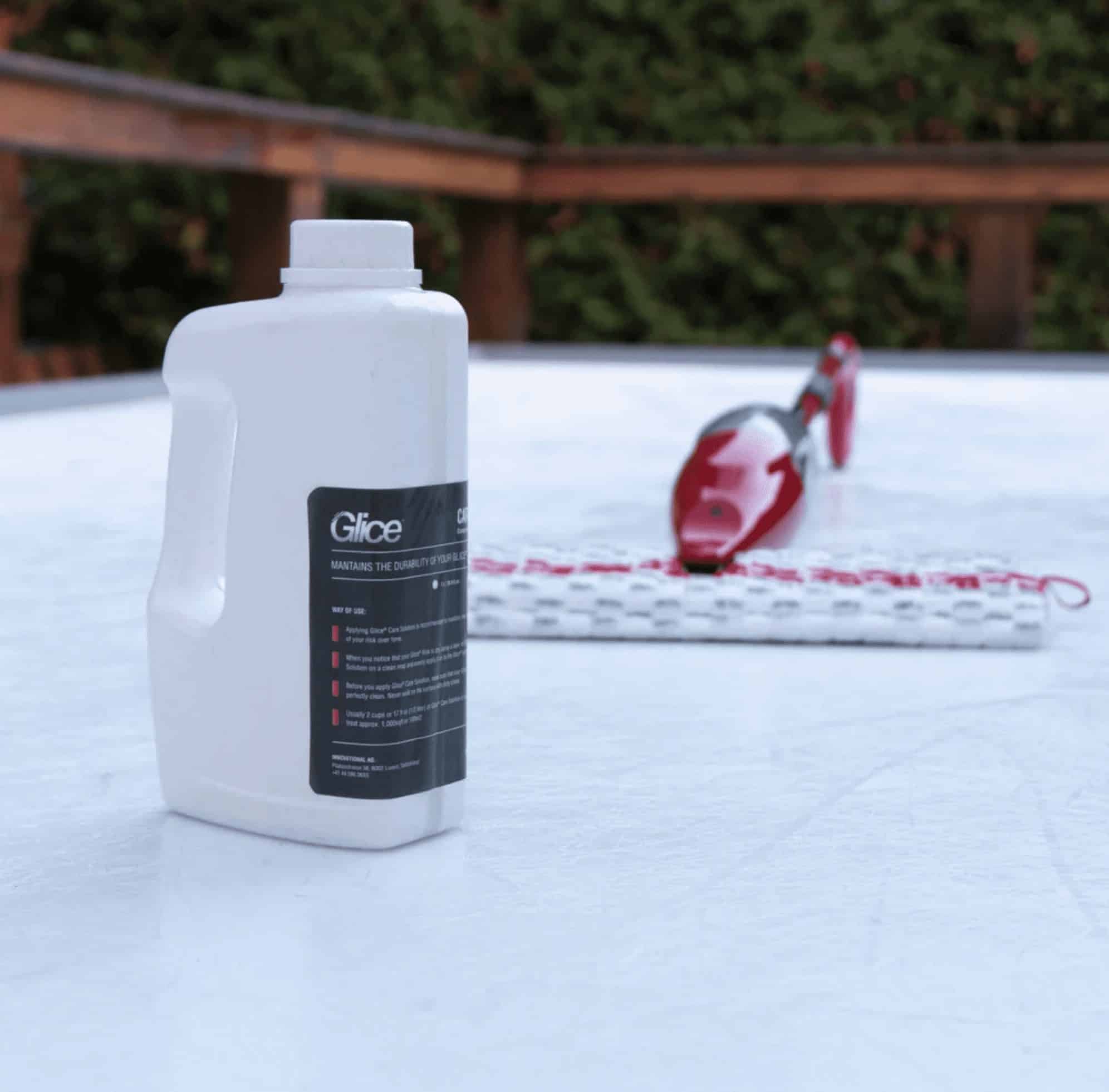
If you have a home rink or are considering acquiring one, you´ll need our Glice Clean and Glice care solutions. Additionally, you should be in possession of a regular home vacuum cleaner and a spray microfiber mob.

For larger skating rinks, we offer a complete set of maintenance equipment, which includes our Glice vacuum cleaner and Smart Polisher, foggers, along with our special Glice Care and Glice Clean solutions.
Our catalog includes all equipment needed for proper maintenance, as pictured above.
Indoor synthetic ice rink maintenance
The amount of maintenance required depends on the usage. The following is helpful for commercial rink applications, which are used for several hours daily.
Daily
We recommend vacuum cleaning the surface each morning. If your rink is smaller than 200m²/2153ft², you can use a traditional vacuum cleaner. If your rink is bigger than 200m²/2153ft², the best option is to use the Glice Vacuum Cleaner.
Every other day: apply Glice Care
After vacuuming cleaning, apply our Glice Care Solution, which will ensure a long-lasting glide effect. We recommend applying it in the evening so it will have time to penetrate the surface. If your rink is less than 200m²/2153ft², apply Glice Care with a spray microfiber mop. If your rink is bigger than 200m², use the Fogger to spray on the solution, then rub it in with a microfiber mop. Only a thin layer is required.
Depending on the use of the ice surface, it might be enough to apply the solution only once a week.
Weekly: apply Glice Clean
Once a week, the surface needs to be thoroughly cleaned. Let this day coincide with the Glice Care application.
Vacuum-clean the surface as usual. Then, mix 5% Glice Clean with water (hot water for very dirty rinks) and apply the solution with a fogger or spray bottle. Let it penetrate for at least 30 minutes, then wet-dry polish the surface with fresh water from the garden hose. Once the surface is dry, apply Glice Care.
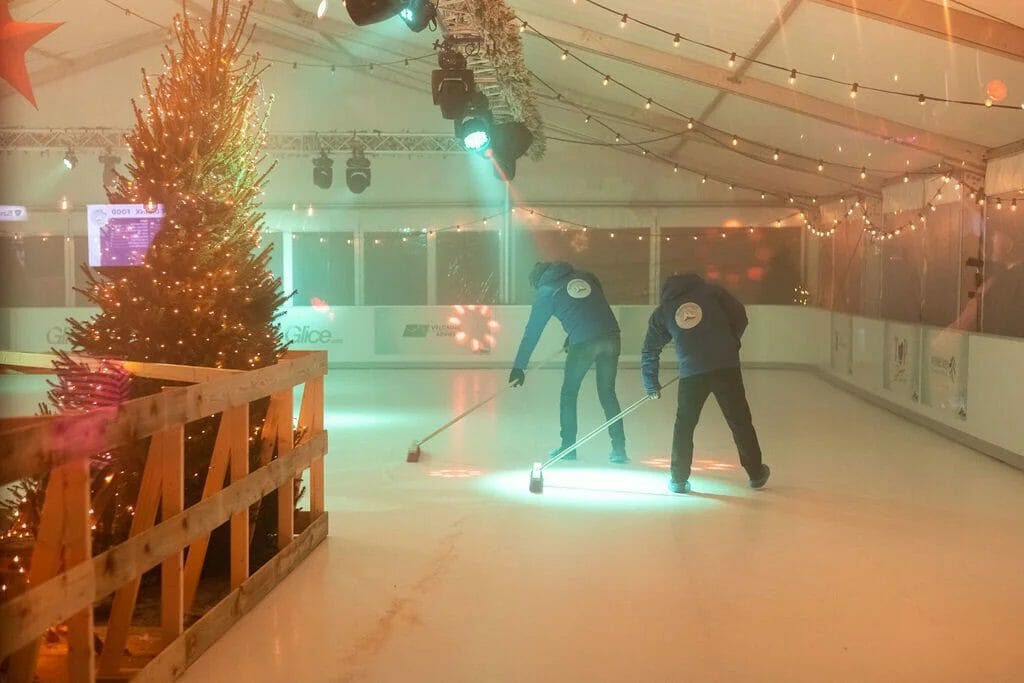
Outdoor ice skating rink maintenance (dry surface)
The amount of maintenance required depends on the usage. The following is helpful for commercial rink applications, which are used for several hours daily. Generally, we recommend using a tarp to cover the panels while not in use to prevent dirt, dust, and debris from covering the surface. This is to minimize the amount of cleaning required.
Daily
Vacuum clean the surface each evening after the final skating session. Why in the evening? This will prevent shaving from flying around during the night. If it rains at night and you haven´t cleaned the rink, the shavings will be mixed with water and difficult to recover and separate afterward. A leaf blower helps gather shavings and debris into a corner of the rink for vacuuming.
For rinks smaller than 200m²/2153ft², you can use a traditional vacuum cleaner. For those larger than 200m²/2153ft², it’s best to use the Glice Vacuum Cleaner.
Twice a day: apply Glice Care
After vacuum cleaning, apply the Glice Care solution, which will ensure a long-lasting glide effect. If your rink is smaller than 200m², use a spray microfiber mop to spray the surface. For bigger sizes, use the Fogger for the application of the solution.
Twice a week: Glice Clean
We recommend deep-cleaning the synthetic ice surface twice weekly. Let these days coincide with the Glice Care application.
First, vacuum-clean the surface as usual. Then, mix 5% Glice Clean with water (hot water if the surface is very dirty) and apply the solution with a fogger or spray bottle. Let it penetrate for at least 30 minutes. Then wet-dry polish the surface with water. Once the surface is dry, apply Glice Care.
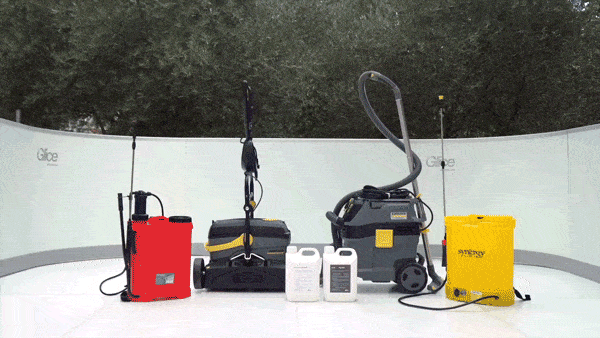
Maintenance under special weather conditions
Always be aware of the weather conditions. If you are expecting freezing temperatures overnight, you will need to prepare the rink for the night and prevent humidity or snow from freezing to the surface. Prevent ice building up overnight by vacuum cleaning the surface in the evening and applying vake defroster with a fogger or spray mob, and rubbing it in. Leave it until the next morning. Then, clean the vake from the surface with a polisher and fresh water. Remove any residual water and allow the rink to dry.
-
There is water on the surface (humidity or rain)
Simply push the water outside the boards with a squeegee until completely dry. A leaf blower can also be used. Afterward, apply Glice Care as described above if required.
If you encounter extreme cold and snowfall, it may make the surface impossible to skate on. Here’s what to do in winter weather:
-
A thin ice layer
First, dry polish the surface with the Glice Polisher. Use only brushes and no water.
Then, push the ice towards the dasher boards with a wide shovel and throw it over.
Another option is to apply vake defroster on the ice and let it penetrate so the ice defrosts. Then, recover the fluid from the surface with the polisher and water. Make sure the surface is dry afterward.
Finally, apply Glice Care to the surface if required and only if the temperature is above zero.
-
A thick ice layer:
Use a special ice scraper to brake and detach the ice from the surface. A pressure washer can also knock the ice off, but residual water must be squeegeed off before it refreezes. Push the ice towards the dasher boards and throw the ice over the boards in a secure spot. Apply Glice Care to the surface if the ambient temperature is above 0°C (32°F). Otherwise, it will immediately freeze back to the surface.
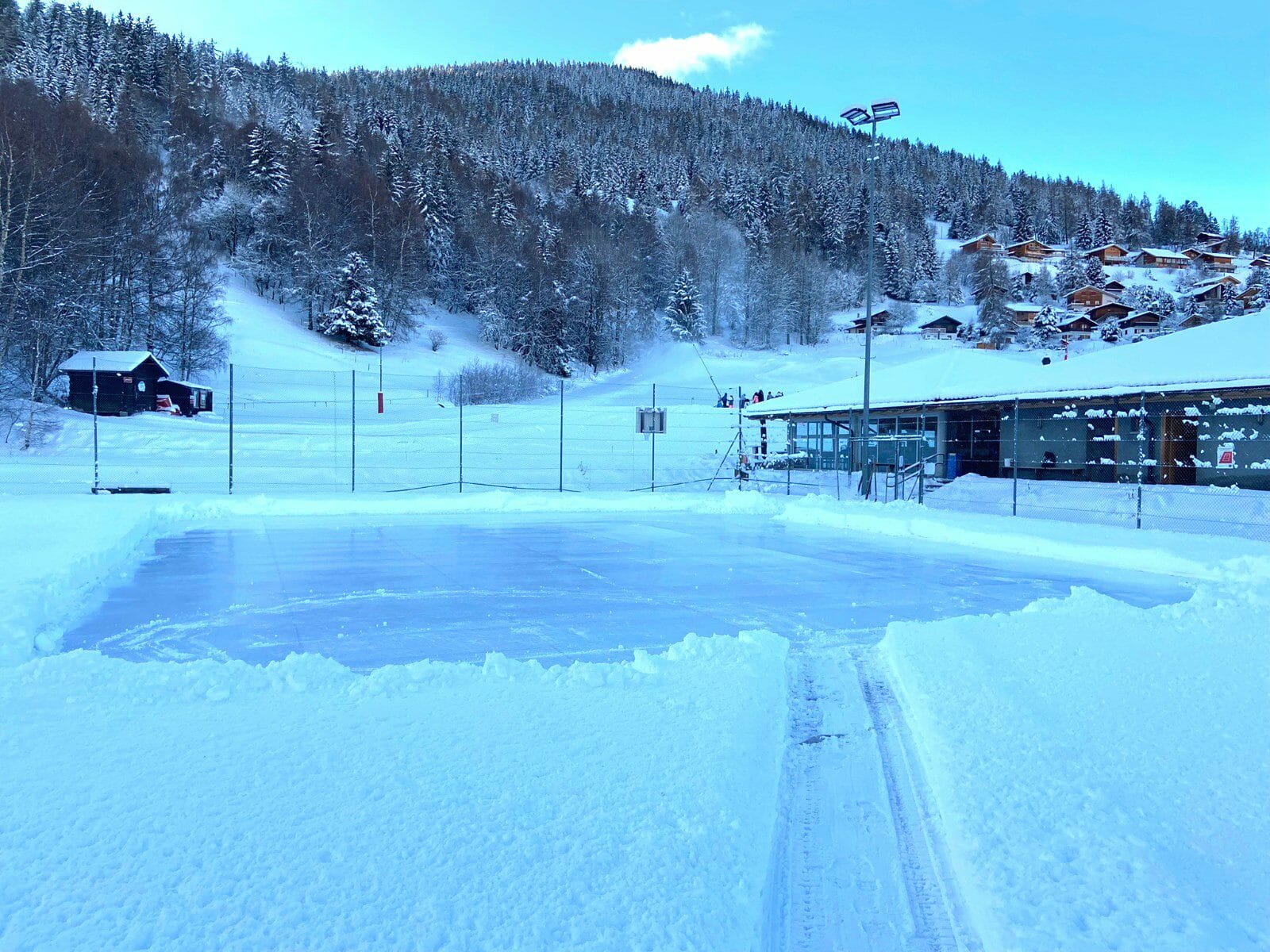
-
In the case of snow
It is essential to remove snow as soon as possible before it starts freezing to the surface.
If the surface is covered in 5 cm (2.5 in) of snow or less: use a show shovel to push the snow toward the dasher boards. We recommend removing one dasher board to push out it out easily.
If there is more than 5 cm (2.5 in) of snow: use a snow blower for the snow removal, blowing it over the side of the dasher board. Be sure the snow blower blades do not come in contact with the skating surface. If a thin layer of ice still covers the surface, use the ice scraper to clear the surface or use the pressure wash method described above.
Clean the vake defroster from the surface with the polisher and fresh water, ensuring it is dry. Apply Glice Care to the surface if required.
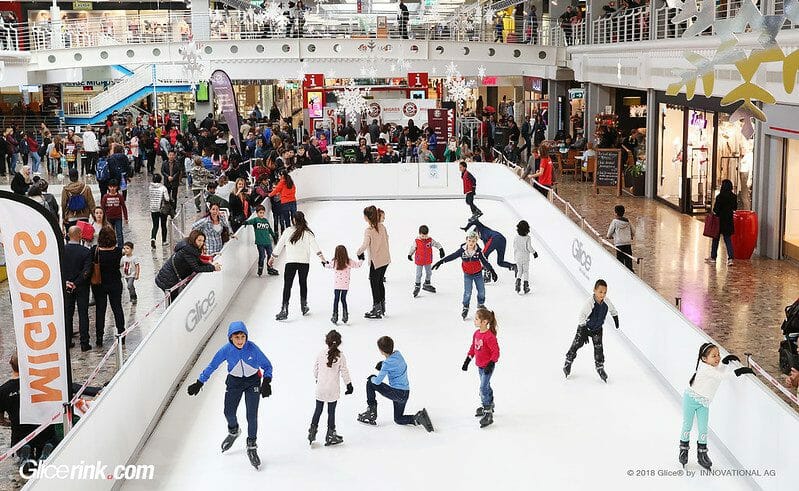
Storing a large Synthetic Ice Rink
While our artificial ice rinks can be used all year round, you might find it convenient to store them for some time of the year. Follow our guidelines for proper storage:
- Clean the synthetic ice surface: Before storing your synthetic ice panels, make sure to clean them thoroughly and remove any dirt or debris. Follow our guidelines on ice maintenance (above) to clean the tiles correctly.
- Let them dry: After cleaning, allow the ice surface to dry completely. If you store them while they’re still wet, it could cause damage to the panels.
- Store the panels: For storing the panels and dasher boards properly without causing any damage, we recommend our pallet boxes shown below. They are specifically designed for our products to ensure they do not suffer any damage during transport and storage. Find a cool, dry place to store your artificial ice tiles, such as a garage or warehouse. Ensure the area is free from excessive moisture and humidity, as this can damage the panels over time.
- Use a cover: Consider using a cover to protect your ice panels in storage. This will help keep them clean and free from dust or debris.
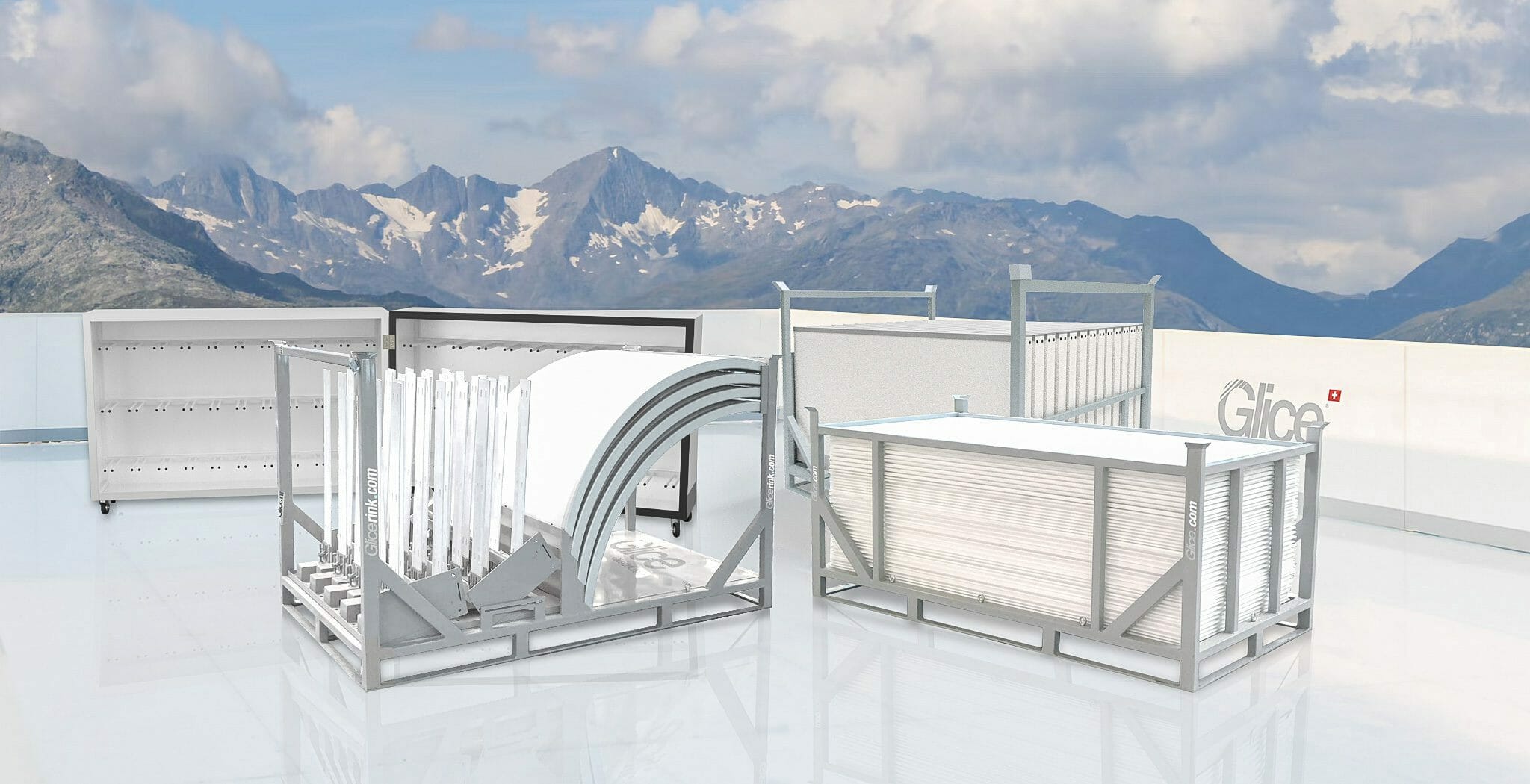
As shown above, an indoor ice rink from us requires regular care to ensure long-lasting high performance. By following these steps on synthetic ice maintenance and storage, you can create a fun and convenient practice space for ice hockey players, figure skaters, and other ice sports enthusiasts. With some care and maintenance, your panels can last for decades. And your ice skates will glide along the surface even more effortlessly.

